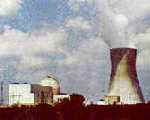作者 傑奇‧艾倫‧朱利安諾 博士
科學工作者關懷聯盟(UCS)提醒我們,美國核能工業遲早會發生意外。該聯盟說,「嚴重的核子意外事故可能對人和環境造成災難性傷害。人為疏失加上機械故障,可能導致數千人死亡、數十萬人受傷、大片土地污染及數十億美元損失的事故。」
科學工作者關懷聯盟相信,由核能管理委員會主導的核子反應爐風險評估,根本算不上真正的風險評估,因為潛在性事故的後續效應並未被列入評量。這份評估僅僅檢查事故或然率,而這只佔風險方程式的一半。關心科學家聯盟也相信事故或然率計算有嚴重缺失,在核能管理委員會的報告以及事實當中,亦發現許多不合理的假設和認定。
以下是一些例子:
‧風險評估認定核能電廠永遠遵守安全規定,但是每年通報的違規案例實際超過一千件。
‧認定電廠沒有任何設計上的問題,即使每年通報的此類案例高達數百件。
‧認定老化不會導致損害,儘管老化材質害死四名工人的證據就在眼前。
‧認定反應爐的壓力槽一定不會故障,即使金屬脆化現象(反應爐壁因暴露於輻射而變得易脆)迫使Yankee Rowe 核能電廠停機。
‧風險評估認定電廠工人可能犯錯的機率遠低於實際運作經驗的證明。
‧風險評估只考慮來自反應爐核心的損害威脅,而不管使用過燃料貯存池中已放射輻射的燃料代表嚴重健康危害的事實。
此外,核能管理委員會也未能建立事故或然率計算的最起碼標準,所有計算均由電廠所有人依照他們自己的假設來進行。科學工作者關懷聯盟的研究顯示,採用上述方式對數個建造方式完全相同、但由不同所有人運作之電廠所進行的案例研究,已經出現謬誤。
例如,Indian Point 2及3核能電廠採用相同的西屋設計均座落於紐約州,由不同的所有人營運。但有報告指出,Indian Point 3發生事故的機率比它的姊妹電廠高出25%。

位在密蘇里州,Fulton東南方10英哩處的卡拉威核能電廠,聯合電力公司(Union Electric Company)所有。(照片提供 美國核能管理委員會)
堪薩斯州的狼溪(Wolf Creek)廠和密蘇里州的卡拉威廠採用相同標準化的西屋設計,建造方式完全一樣;但對某些相同事件而言,在卡拉威廠的報告顯示其可能導致反應爐核心損害的機率,比狼溪廠高出10到20倍。
更糟的是,核能管理委員原會允許電廠所有者減少對安全設備的測試和檢查,進一步增加了風險。核管會基於一些既不完整亦不精確的意外機率評估,同意裁減安全工作。
令人驚訝的是,核能管理委原會的風險評估假設火警能夠百分之百被控制。這真的令人震驚,因為在這個年頭裡,核電廠出狀況有可能會造成幾萬人死亡,火災控制在核電廠區是相當受到重視的焦點。
幾年前,瓦特福特核電廠(地近路易西安那州的Taft) 的一位工作人員發現渦輪機建築冒出濃煙,火災警報器足足遲了29分鐘才響起,以便工作人員穿過濃煙尋找火源。
此間,控制室的操作員一直忽略火燄偵測器的警報,他們忙著指揮工作人員尋找火源。後來電廠的消防隊終於動員了,但是消防隊隊長卻不允許隊員用水滅火以免傷害到電子設備,結果火燄延燒超過一個小時。最後消防隊員終於獲准用水,在四分鐘內就把火撲滅了。若再發生一次這種烏龍事件,結果可能會是個大災難。
正在成形中的災難還有很多,比方說,1997共有9座核能電場整年關閉,對那些久未保養的緊急設備進行維修工作。這些電場在其緊急系統無法正常發揮功能的狀況下運轉了好幾年。
在這些瘋狂狀況日益擴大之前,我們必須加以阻止。我們必須嚴格要求發展安全的替代能源,而非那些代表著美國總統政府個人利益和投資的骯髒核能和化石燃料政策。民眾必須要求以理性來規劃能源政策。
布希總統試圖要保衛的「美國風格」,破壞了生態系統的可持續性,並且將會給所有男女老少帶來災難性的後果。
By Jackie Alan Giuliano, Ph.D
The Union of Concerned Scientists (UCS) reminds us that the U.S. nuclear energy industry is an accident waiting to happen. UCS says, "A severe nuclear accident has the potential to do catastrophic harm to people and the environment. A combination of human and mechanical error could result in an accident killing several thousand people, injuring several hundred thousand others, contaminating large areas of land, and costing billions of dollars."
The UCS believes that the nuclear reactor risk assessments conducted by the Nuclear Regulatory Commission are really not risk assessments at all because potential accident consequences are not evaluated. The assessments merely examine accident probabilities, which is only half of the risk equation. Union of Concerned Scientists also believes that accident probability calculations are seriously flawed and have found many irregularities in NRC reporting and the facts.
Here are a few examples:
‧The risk assessments assume nuclear plants always conform with safety requirements, yet each year more than a thousand violations are reported.
‧Plants are assumed to have no design problems even though hundreds are reported every year.
‧Aging is assumed to result in no damage, despite evidence that aging materials killed four workers.
‧Reactor pressure vessels are assumed to be failure proof, even though embrittlement (reactor walls becoming brittle due to radiation exposure) forced the Yankee Rowe nuclear plant to shut down.
‧The risk assessments assume that plant workers are far less likely to make mistakes than actual operating experience demonstrates.
‧The risk assessments consider only the threat from damage to the reactor core despite the fact that irradiated fuel in the spent fuel pools represents a serious health hazard.
Also, the NRC has failed to establish any minimum standards for the accident probability calculations, all of which are conducted by plant owners, each with their own assumptions. Union of Concerned Scientists' research has shown the fallacy of conducting studies in this way with a number of case studies done on plants that were built identically, but operated by different owners.
For example, the Indian Point 2 and 3 nuclear plants share the same Westinghouse design and sit side by side in New York, but are operated by different owners. On paper, Indian Point 3 is more than 25 percent more likely to experience an accident than her sister plant.

Owned and operated by the Union Electric Company, the Callaway nuclear plant is 10 miles southeast of Fulton, Missouri. (Photo courtesy NRC)
The Wolf Creek plant in Kansas and the Callaway plant in Missouri were built identically, sharing the same standardized Westinghouse design. But some events at Callaway are reported to be 10 to 20 times more likely to lead to reactor core damage than the same events at Wolf Creek.
To make matters worse, the Nuclear Regulatory Commission is allowing plant owners to cut back on tests and inspections of safety equipment, further increasing risks. The NRC approves these reductions based on the results from the incomplete and inaccurate accident probability assessments.
Surprisingly, one of the NRC risk assessments that is assumed to be 100 percent controlled is fire suppression. It is shocking that in this day and age, fire control is actually a concern at nuclear facilities, facilities that could kill tens of thousands of people in the event of a disaster.
A few years ago, a worker at the Waterford nuclear plant, near Taft, Louisiana, reported heavy smoke in the turbine building. The plant's fire alarm was not sounded for 29 minutes so workers could search through heavy smoke for the source of the flames.
During this time, fire detector alarms in the control room were ignored by operators who were busy directing workers who searched for the fire. When the plant's fire brigade finally responded, the fire brigade leader did not allow water to be used because of the electrical equipment. As a result, the fire blazed for over an hour. When use of water was finally allowed, the fire was put out within four minutes. Another comedy of errors like this could have disastrous consequences.
The list is very long of disasters in the making. For example, nine U.S. nuclear power plants were shut down for all of 1997 while their owners made extensive repairs to emergency equipment that were long overdue. Each of these plants had operated for years with emergency systems that would not have functioned as required in event of an accident.
We have to stop this madness before it escalates. We must demand that safe, alternative forms of energy be developed rather the dirty nuclear and fossil fuels that represent the personal interests and investments of the U.S. Presidential administration. The people must demand that reason return to energy policy.
The "American Way" that President Bush seeks to protect is unsustainable and has disastrous consequences for the ecosystem and every woman, man and child alive.
全文及圖片詳見:http://ens-news.com/ens/jun2001/2001L-06-01g.html
參考資料
1.請至美國核能管理委員會的網站,參閱執照換發程序說明:http://www.nrc.gov/NRC/REACTOR/LR/
2.起身參與並發出怒吼吧!迫使那些老舊電廠關門或重建老舊組件,請造訪美國核能管理委員會的民眾參與(Public Involvement) 網站,並提出你的意見:http://www.nrc.gov/NRC/public.html
3. 科學工作者關懷聯盟幫助你瞭解如何反對布希的能源方案:http://www.ucsusa.org/act/act_scheme.html
4.到核能管理委員會營運中心(Operations Center)查看每日記事(Daily Events):http://www.nrc.gov/NRR/DAILY/der.htm。做好受驚嚇的心理準備吧。
5.關於全美所有的核子反應爐及其執照到期日的相關資訊,請造訪 http://www.nrc.gov/NRC/NUREGS/SR1350/V12/part11.html。
6.有關全世界的核子反應爐,請造訪 http://www.nrc.gov/NRC/NUREGS/SR1350/V12/part19.html
7.造訪核能守衛圖書館 (Nuclear Guardianship Library),了解我們能對悲慘的核子廢料後遺症做些什麼:http://www.nonukes.org/ngl.htm
8. 找出誰是你的國會代表,並寫e-mail給他們,要求他們阻止政府不加思索地就讓危險的核能電廠通過執照換發。根據你的郵遞區號,可在這網站找到他們http://www.visi.com/juan/congress/ziptoit.html
傑奇‧艾倫‧朱利安諾博士,是西雅圖的教師兼作家。他正在思考著,在他的新生兒長大後,對於那些過去曾是核子反應爐廠址的地方,被破壞、棄置,他會認識多少個類似的故事。請將你的想法、評論與觀察寄到以下的郵件信箱給他:jackie@healingourworld.com,或是造訪他的網頁:http://www.healingourworld.com
【文章連載】
■生活中已充斥著幅射線-電廠仍然得以換發營運執照 (上) (下)




